Corrosion Behavior of Steels in LiBr–H2O–CaCl2–LiNO3 Systems
Abstract
:1. Introduction
2. Experimental Procedure
2.1. Testing Materials
2.2. Testing Solution
2.3. Electrochemical Techniques
3. Results and Discussion
3.1. Open Circuit Potential Values
3.2. Potentiodynamic Polarization Curves
3.3. Electrochemical Impedance Spectroscopy
4. Conclusions
Author Contributions
Funding
Data Availability Statement
Conflicts of Interest
References
- Ochoa, A.A.V.; Dutra, J.C.C.; Henríquez, J.R.G.; Rohatgi, J. Energetic and exergetic study of a 10RT absorption chiller integrated into a microgeneration system. Energy Convers. Manag. 2014, 88, 545–553. [Google Scholar] [CrossRef]
- Cézar, K.L.; Caldas, A.G.A.; Caldas, A.M.A.; Cordeiro, M.C.L.; Dos Santos, C.A.C.; Ochoa, A.A.V.; Michima, P.S.A. Development of a novel flow control system with arduino microcontroller embedded in double effect absorption chillers using the LiBr/H2O pair. Int. J. Refrig. 2020, 111, 124–135. [Google Scholar] [CrossRef]
- Du, S.; Wang, R.Z.; Chen, X. Development and experimental study of an ammonia water absorption refrigeration prototype driven by diesel engine exhaust heat. Energy 2017, 130, 420–432. [Google Scholar] [CrossRef]
- Mosa, M. Effect of Variable Thermo-Physical Properties of LiBr-H2O Solution on the Performance Parameters of Horizontal Tube Absorber. Int. J. Air-Cond. Refrig. 2019, 27, 1950026. [Google Scholar] [CrossRef]
- Cezar, K.; MacArio, A.; Cabral Dos Santos, C.A.; Ochoa, A.; Charamba Dutra, J.C. Flow Control for Absorption Chillers Using the Par H2O/LiBr Driven in Recirculation Pumps of Low Power. IEEE Lat. Am. Trans. 2016, 14, 1624–1629. [Google Scholar]
- Butt, I.B.; Tan, J.; Waqas, A.; Ali, M.; Javed, A.; Ali, A.Y. Effect of modified flow schemes of heat transfer fluid on the performance of a solar absorption-cooling system for an educational building in Pakistan. Appl. Sci. 2020, 10, 3327. [Google Scholar] [CrossRef]
- Liang, C.; Hu, X. Inhibition Performance of Enhanced-Mo Inhibitor for Carbon Steel in 55% LiBr Solution. J. Iron Steel Res. Int. 2008, 15, 49–54. [Google Scholar] [CrossRef]
- Hu, X.; Liang, C.; Huang, N. Anticorrosion Performance of Carbon Steel in 55% LiBr Solution Containing PMA/SbBr3 Inhibitor. J. Iron Steel Res. Int. 2006, 13, 56–60. [Google Scholar] [CrossRef]
- Zolfaghari, S.; Baboukani, A.R.; Ashrafi, A.; Saatchi, A. Investigation the effects of Na2MoO4 as an inhibitor on electrochemical corrosion behavior of 316L stainless steel in LiBr solution. Zast. Mater. 2018, 59, 108–116. [Google Scholar] [CrossRef] [Green Version]
- Youssef, G.I.; El Meleigy, A.E.; Khorshed, L.A.; Attia, A.; Ashour, E.A. Inhibitive effect of benzotriazole on the corrosion and corrosion fatigue of α-Al bronze alloy in LiBr solution. Mater. Corros. 2018, 69, 1827–1836. [Google Scholar] [CrossRef]
- El Hamid, S.E.A.; Abeer El Meleigy, E.; Attia, A.; El Fattah El Warraky, A.A.; Abd-El-Wahab, S.M. Corrosion Behaviour of Copper– nickel Alloys in LiBr Solutions: A Comparative Study. Egypt. J. Chem. 2020, 63, 907–919. [Google Scholar]
- Yoo, J.; Han, S.; Nam, Y.; Jeong, S. Effect of shot-peening on the passive film formation and corrosion of carbon steel in LiBr aqueous solution. J. Mech. Sci. Technol. 2020, 34, 4037–4041. [Google Scholar] [CrossRef]
- Cho, Y.; Han, S.; Seo, H.; Woo, S. Corrosion and inhibition process of carbon steel in LiBr-H2O solution. J. Mech. Sci. Technol. 2019, 33, 2995–3000. [Google Scholar] [CrossRef]
- Guiñon, J.L.; Garcia-Anton, J.; Pérez-Herranz, V.; Lacoste, G. Corrosion of Carbon Steels, Stainless Steels, and Titanium in Aqueous Lithium Bromide Solution. Corrosion 1994, 50, 240–246. [Google Scholar] [CrossRef]
- Guiñón-Pina, V.; Igual-Muñoz, A.; García-Antón, J. Influence of Temperature on the Corrosion Behaviour and on the Hydrogen Evolution Reaction on Nickel and Stainless Steels in LiBr Solutions. Int. J. Electrochem. Sci. 2011, 6, 6123–6140. [Google Scholar]
- Li, N.; Luo, C.; Su, Q. A working pair of CaCl2–LiBr–LiNO3/H2O and its application in a single-stage solar-driven absorption refrigeration cycle. Int. J. Refrig. 2018, 86, 1–13. [Google Scholar] [CrossRef]
- Li, Y.; Li, N.; Luo, C.; Su, Q. Study on a Quaternary Working Pair of CaCl2-LiNO3-KNO3/H2O for an Absorption Refrigeration Cycle. Entropy 2019, 21, 546. [Google Scholar] [CrossRef] [Green Version]
- Torres-Díaz, T.; Siqueiros, J.; Coronas, A.; Salavera, D.; Huicochea, A.; Juárez-Romero, D. Performance of Li salts (LiBr + LiI + LiNO3+ LiCl) for an absorption cycle of an experimental absorption heat transformer for water purification. Desalin. Water Treat. 2017, 82, 292–299. [Google Scholar] [CrossRef]
- Yang, Y.; Lin, C.; Zhao, X.; Zhang, Y. Initial Stage Cavitation-corrosion of TA2 in Aqueous LiBr Solution. J. Chin. Soc. Corros. Prot. 2017, 37, 540–546. [Google Scholar]
- Soliz, A.; Mayrhofer, K.J.J.; Cáceres, L. Influence of Hydrodynamic Flow Patterns on the Corrosion Behavior of Carbon Steel in a Neutral LiBr Solution. Int. J. Electrochem. Sci. 2018, 13, 10050–10075. [Google Scholar]
- Kappes, M.A. Localized corrosion and stress corrosion cracking of stainless steels in halides other than chlorides solutions: A review. Corros. Rev. 2020, 38, 1–24. [Google Scholar] [CrossRef] [Green Version]
- Irie, T.; Morihashi, D.; Hirohata, Y.; Haruna, T. Polarization Curves of Carbon Steel in Concentrated LiBr Solutions Containing LiOH and Li2MoO4 at Different Temperatures after Short Immersion. Mater. Trans. 2021, 62, 420–426. [Google Scholar] [CrossRef]
- Hu, S.; Liu, R.; Liu, L.; Cui, Y.; Wang, F. Influence of temperature and hydrostatic pressure on the galvanic corrosion between 90/10 CueNi and AISI 316L stainless steel. J. Mater. Res. Technol. 2021, 13, 1402–1405. [Google Scholar] [CrossRef]
- Muñoz-Portero, M.J.; Nachiondo, T.; Blasco-Tamarit, E.; Vicent-Blesa, A.; García-Antón, J. Potential-pH diagrams for Iron in Concentrated LiBr Solutions at 25 °C. Corrosion 2018, 74, 1102–1116. [Google Scholar] [CrossRef]
- Fernández-Domene, R.M.; Blasco-Tamarit, E.; García-García, D.M.; Antón, J.G. Passivity Breakdown of Titanium in LiBr Solutions. J. Electrochem. Soc. 2014, 161, C25–C31. [Google Scholar] [CrossRef]
- Guiñón-Pina, V.; Igual-Muñoz, A.; García-Antón, J. Influence of temperature and applied potential on the electrochemical behaviour of nickel in LiBr solutions by means of electrochemical impedance spectroscopy. Corros. Sci. 2009, 51, 2406–2413. [Google Scholar] [CrossRef]
- Jiangzhou, S.; Wang, R.Z. A compressor-assisted triple-ffect H2O-LiBr absorption cooling cycle coupled with a Rankine Cycle driven by high-temperature waste heat. Appl. Therm. Eng. 2001, 21, 1161–1168. [Google Scholar] [CrossRef]
- Blasco-Tamarit, E.; García, D.M.; García-Antón, J. Thermogalvanic effects on the corrosion of copper in heavy brine LiBr solutions. Corros. Sci. 2012, 63, 304–311. [Google Scholar]
- Muñoz-Portero, M.J.; García-Antón, J.; Guiñón, J.L.; Perez-Herranz, V. Corrosion of Copper in Aqueous Lithium Bromide Concentrated Solutions by Immersion Testing. Corrosion 2006, 62, 1018–1025. [Google Scholar] [CrossRef]
- Ren, S.J.; Charles, J.; Wang, X.C.; Nie, F.X.; Romero, C.; Neti, S.; Zheng, Y.; Hoenig, S.; Chen, C.; Cao, F.; et al. Corrosion testing of metals in contact with calcium chloride hexahydrate used for thermal energy storage. Mater. Corros. 2017, 68, 1046–1056. [Google Scholar] [CrossRef]
- Itoh, M.; Itoh, K.; Izumiya, M.; Tanno, K. Corrosion Behavior of Carbon Steels and Low Alloy Steels in Concentrated LiBr-CaCl2 Solution at Elevated Temperature. Boshoku Gijutsu 1989, 38, 645–651. [Google Scholar]
- Li, J.; Liang, C.; Huang, N. Effect of B-Mo-W Complex Inhibitor on Corrosion of Mild Steel in 55% LiBr Solution. J. Mater. Eng. Perform. 2015, 24, 4456–4461. [Google Scholar] [CrossRef]
- Abd El Meguid, E.A.; Abd El Rehim, S.S.; Al Kiey, S.A. Inhibitory effect of cetyltrimethyl ammonium bromide on the corrosion of 904L stainless steel in LiBr solution. Corros. Eng. Sci. Technol. 2016, 51, 429–435. [Google Scholar] [CrossRef]
- Osta-Omar, S.M.; Micallef, C. Determination of Concentration of the Aqueous Lithium–Bromide Solution in a Vapour Absorption Refrigeration System by Measurement of Electrical Conductivity and Temperature. Data 2017, 2, 6. [Google Scholar] [CrossRef] [Green Version]
- Jian, S.; Lin, F.; Shigang, Z. Experimental evaluation of a direct air-cooled lithium bromide–water absorption prototype for solar air conditioning. Appl. Therm. Eng. 2010, 30, 2680–2684. [Google Scholar] [CrossRef]
- Rahmouni, K.; Keddam, M.; Srhiri, A.; Takenouti, H. Corrosion of copper in 3% NaCl solution polluted by sulphide ions. Corros. Sci. 2005, 47, 3249–3266. [Google Scholar] [CrossRef]
- Luo, C.; Su, Q.; Li, N.; Li, Y. Corrosion of Copper in a Concentrated LiNO3 Solution at a High Temperature. Int. J. Electrochem. Sci. 2017, 12, 1896–1914. [Google Scholar] [CrossRef]
- Guo, J.; Liang, C. Corrosion of carbon steel in concentrated LiNO3 solution at high temperature. Corros. Eng. Sci. Technol. 2002, 14, 197–204. [Google Scholar]
- Tanno, K.; Itoh, M.; Sekiya, H.; Yashiro, H.; Kumagai, N. The corrosion inhibition of carbon steel in lithium bromide solution by hydroxide and molybdate at moderate temperaturas. Corros. Sci. 1993, 34, 1453–1461. [Google Scholar] [CrossRef]
- Kyung-Hwan, N.; Su-Il, P. Effects of sulphate, nitrate and phosphate on pit initiation of pure aluminium in HCl-based solution. Corros. Sci. 2007, 49, 2663–2675. [Google Scholar] [CrossRef]
- Samiento-Bustos, E.; González Rodriguez, J.G.; Uruchurtu, J.; Dominguez-Patiño, G.; Salinas-Bravo, V.M. Corrosion behavior of iron-based alloys in the LiBr+ ethylene glycol+ H2O mixture. Corros. Sci. 2008, 50, 2296–2312. [Google Scholar] [CrossRef]
- Abd El Meguid, E.A. Pitting corrosion behavior of type 904L stainless steel in sodium bromide solutions. Corrosion 1997, 53, 623–630. [Google Scholar] [CrossRef]
- Kaneko, M.; Isaacs, H.S. Pitting of stainless steel in bromide, chloride and bromide/chloride solutions. Corros. Sci. 2000, 42, 67–78. [Google Scholar] [CrossRef]
- Abd El Meguid, E.A.; Mahmoud, N.A. Inhibition of bromide-pitting corrosion of type 904L stainless steel. Corrosion 2003, 59, 104–111. [Google Scholar] [CrossRef]
- Oltra, R.; Keddam, M. Application of EIS to Pitting Corrosion. Electrochim. Acta 1990, 35, 1619–1629. [Google Scholar] [CrossRef]
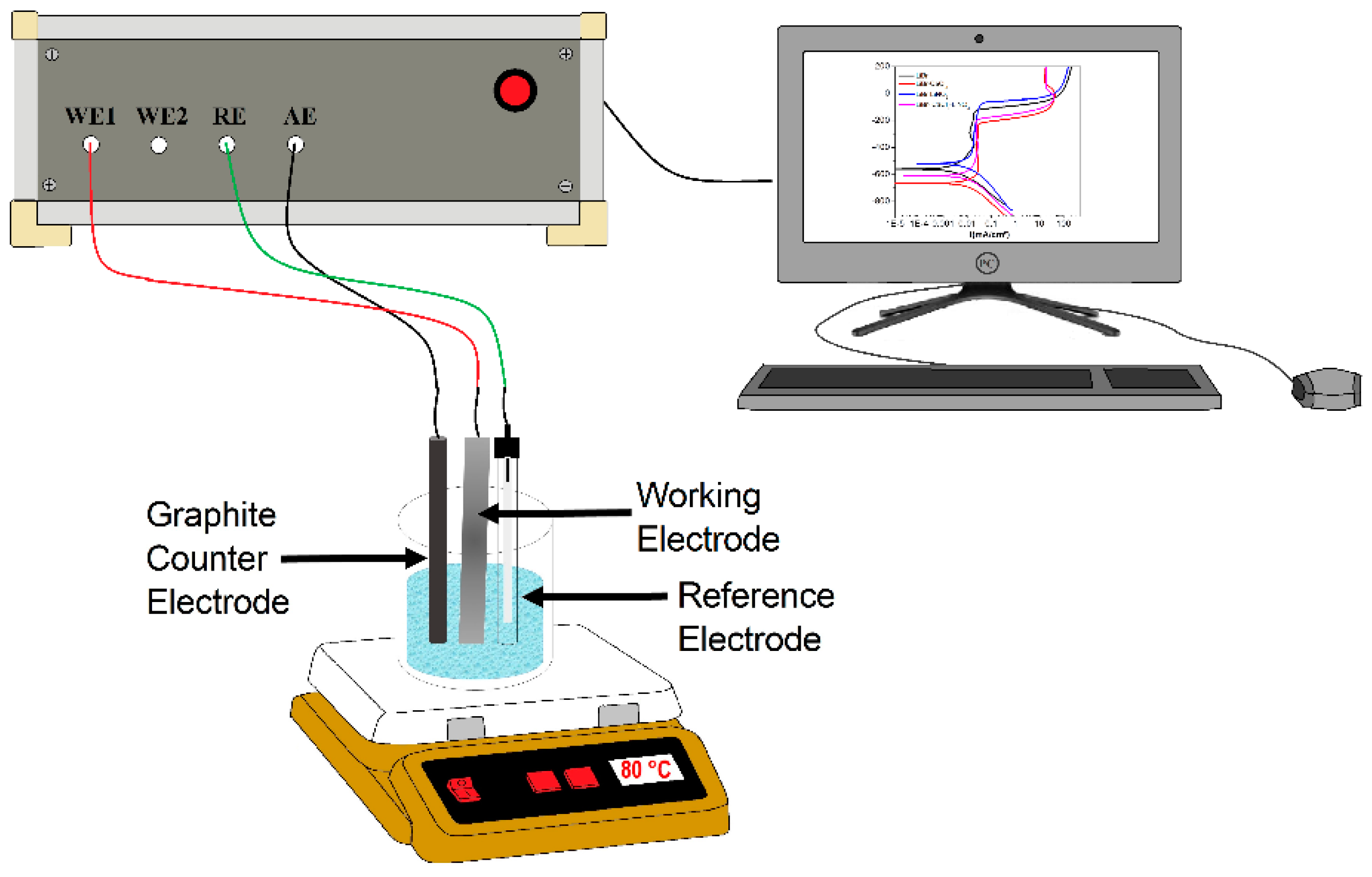
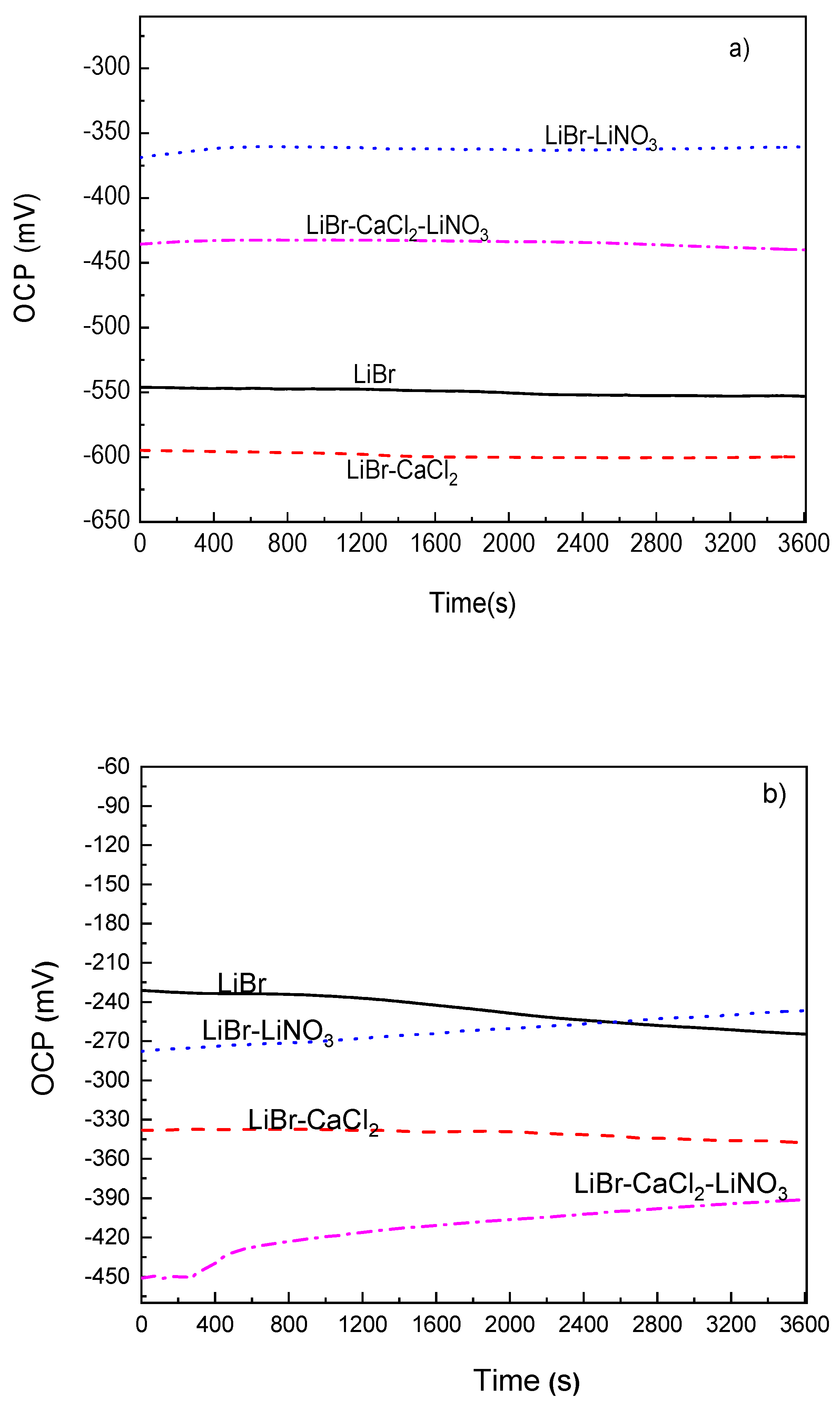
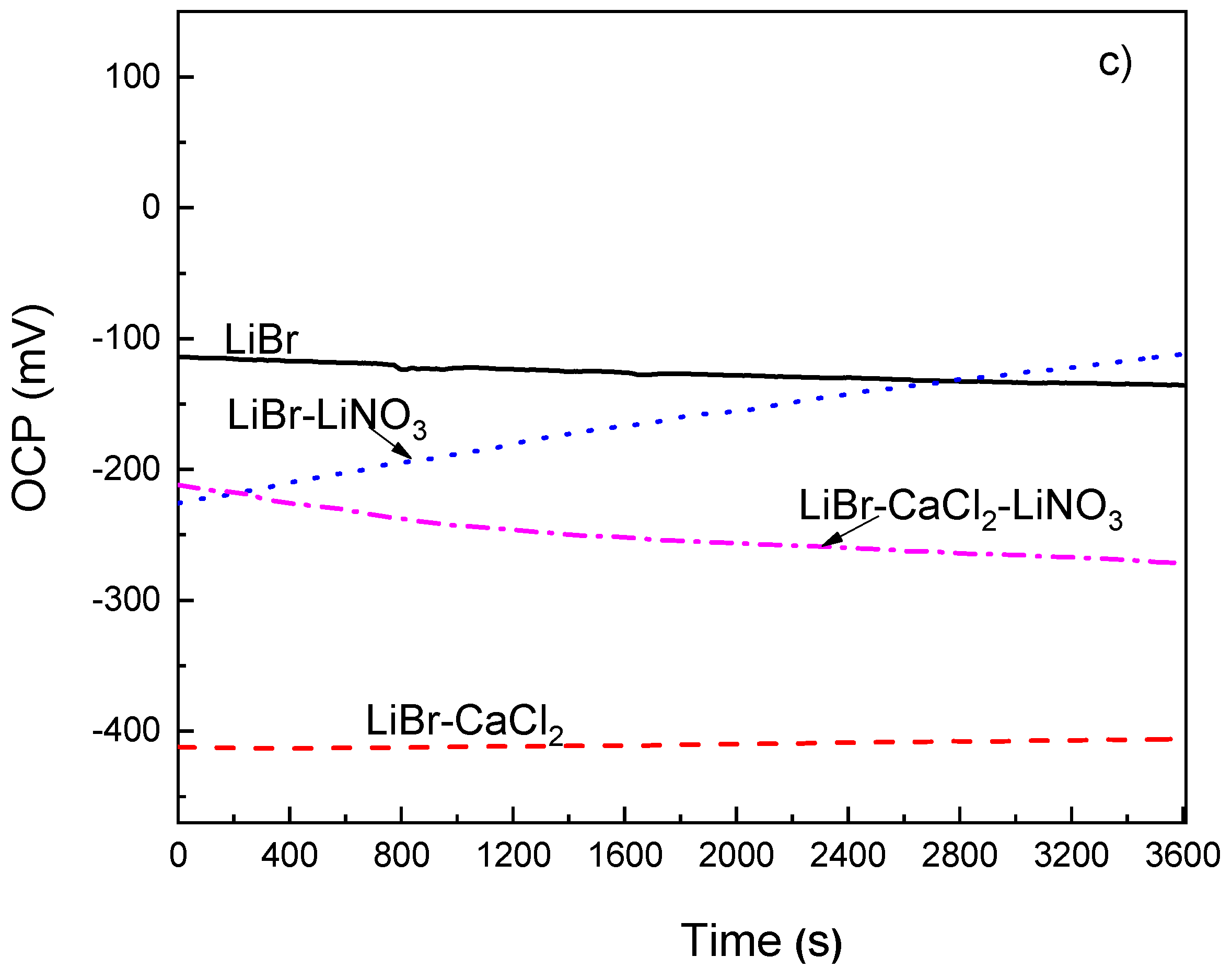
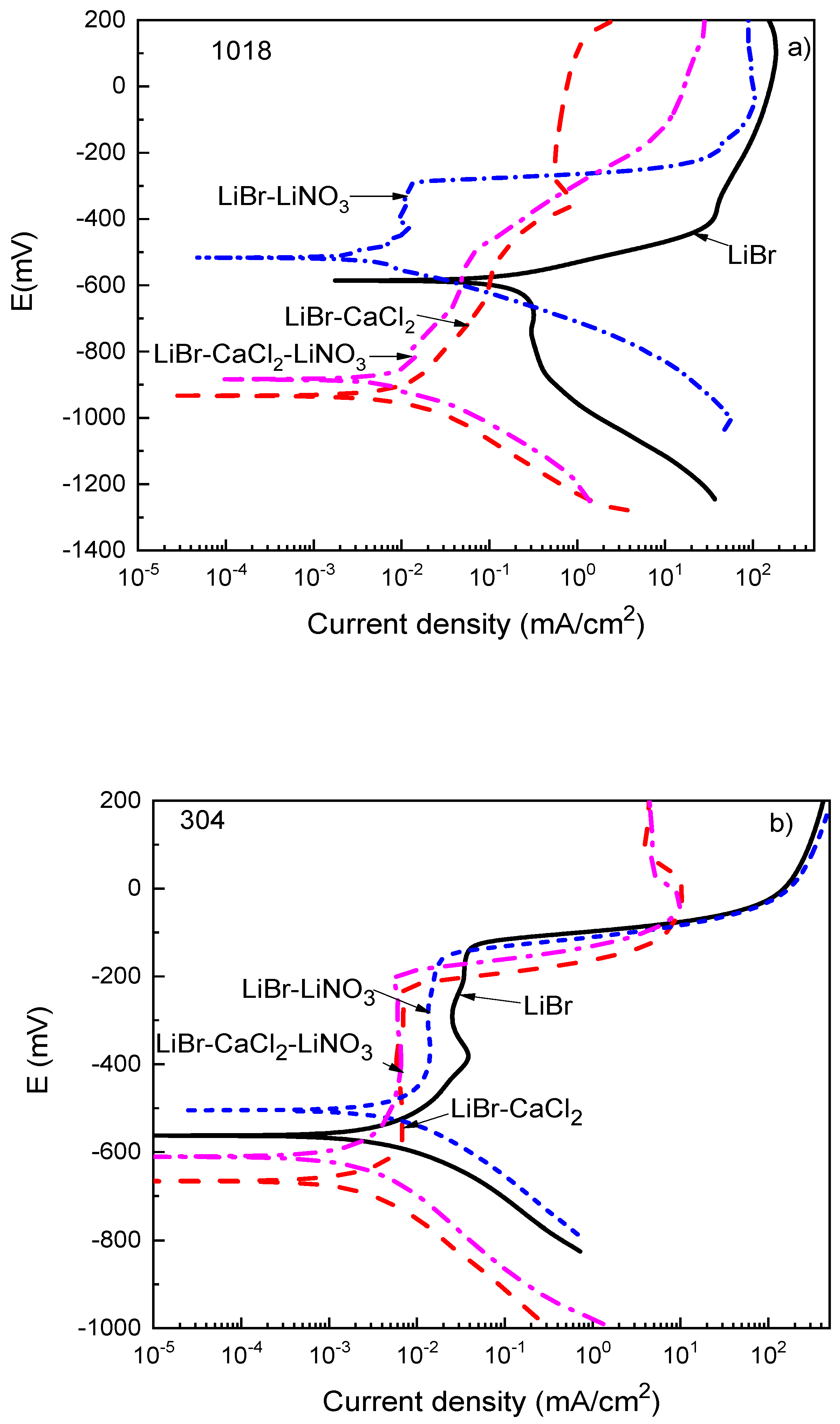
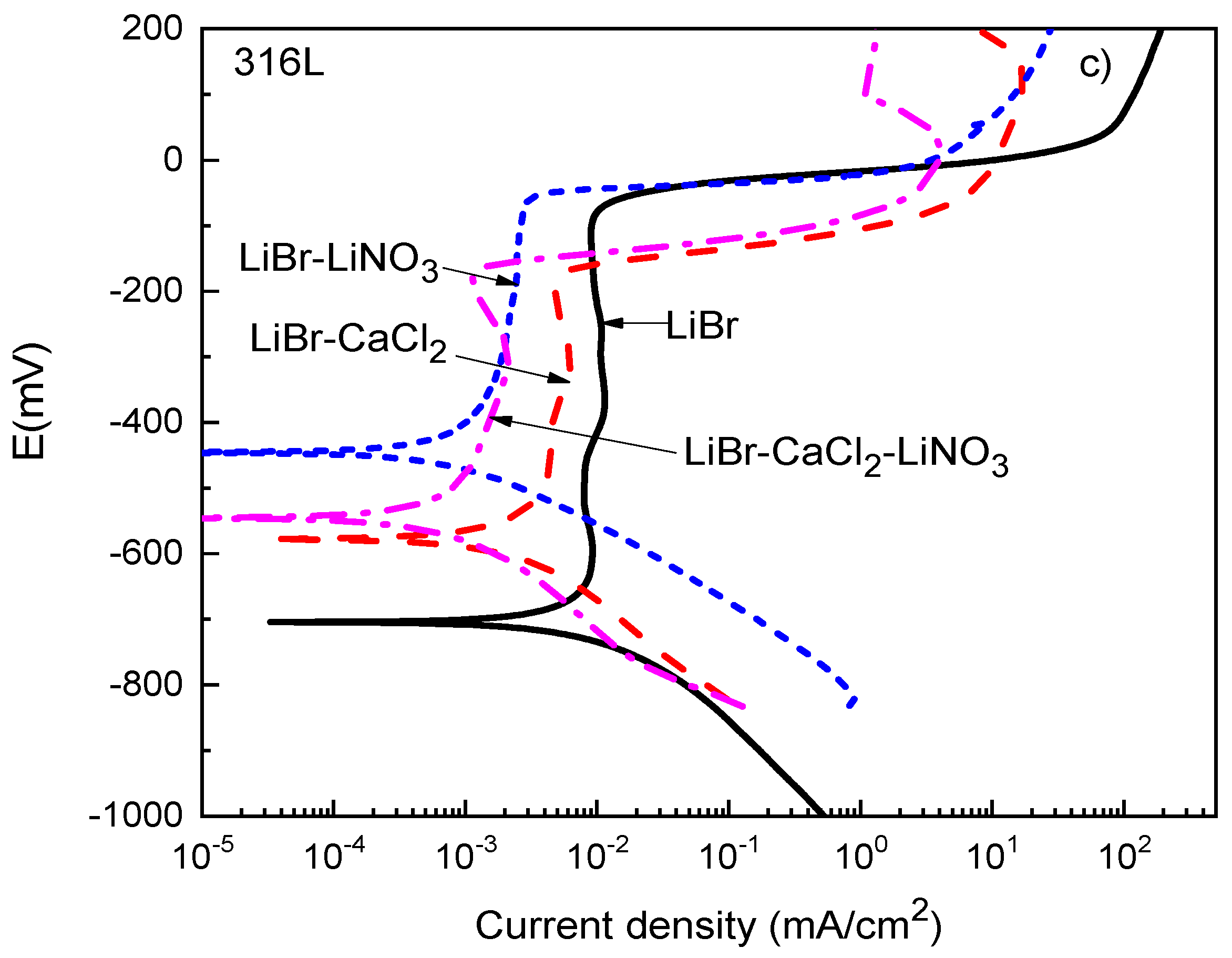
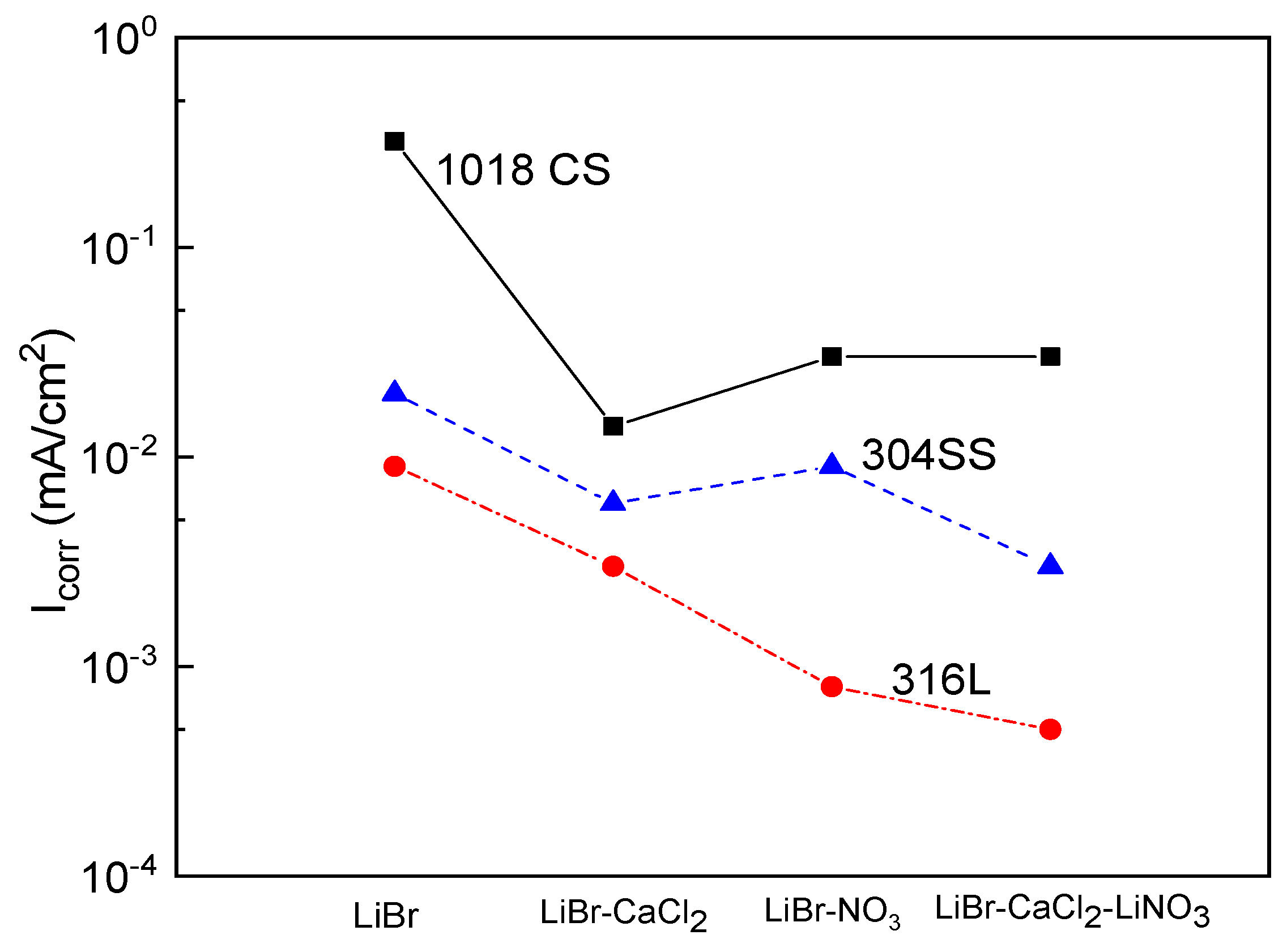
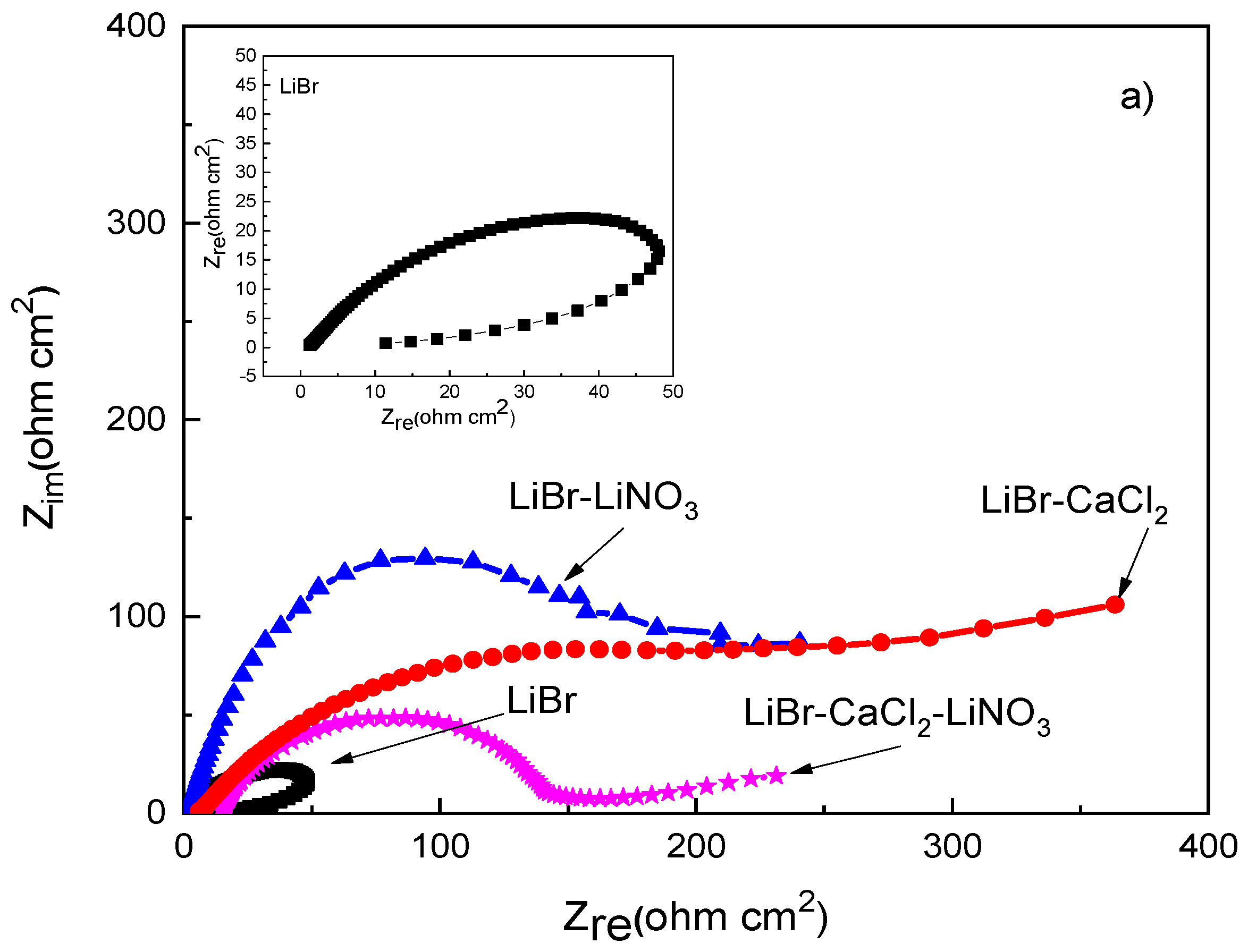
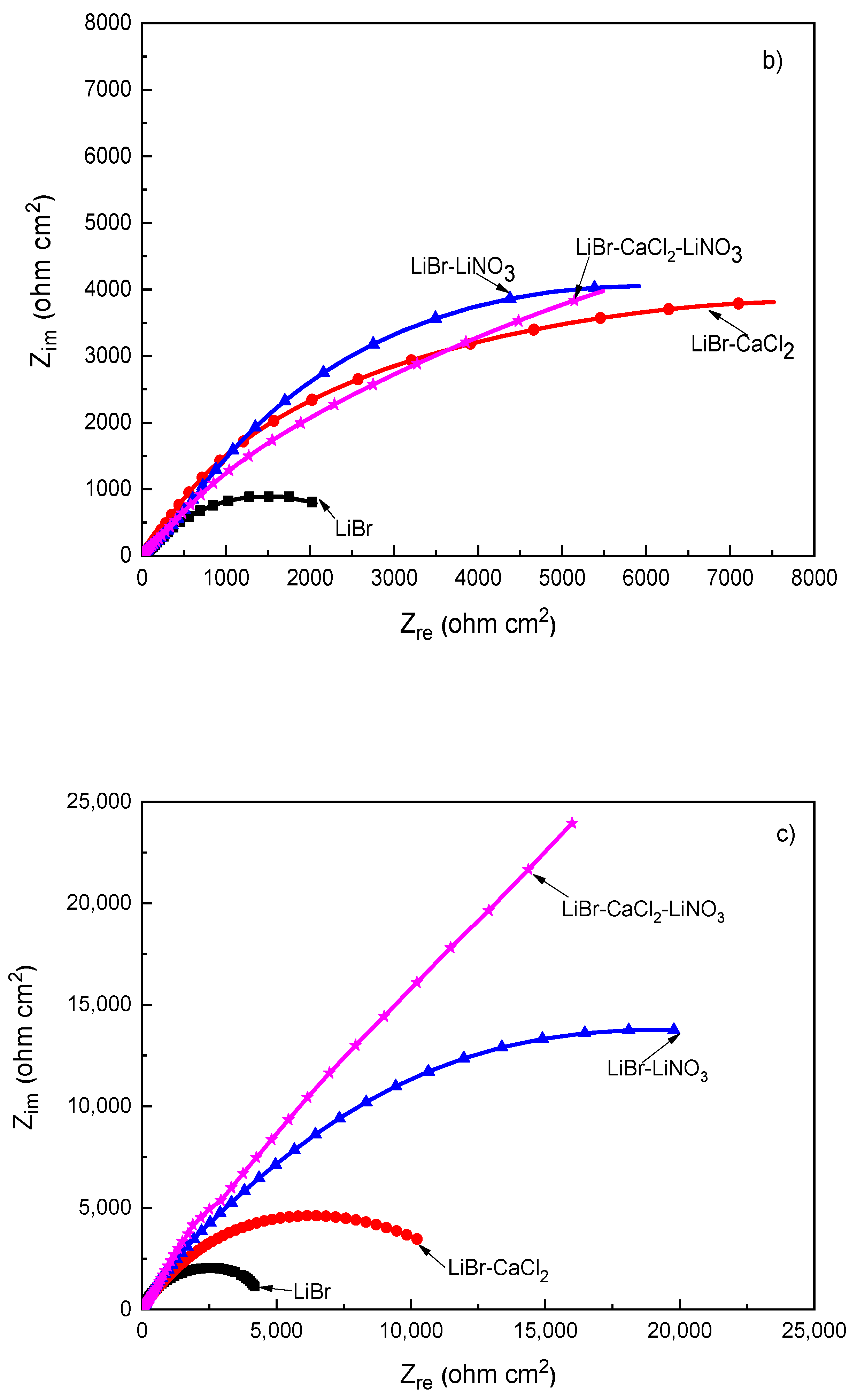

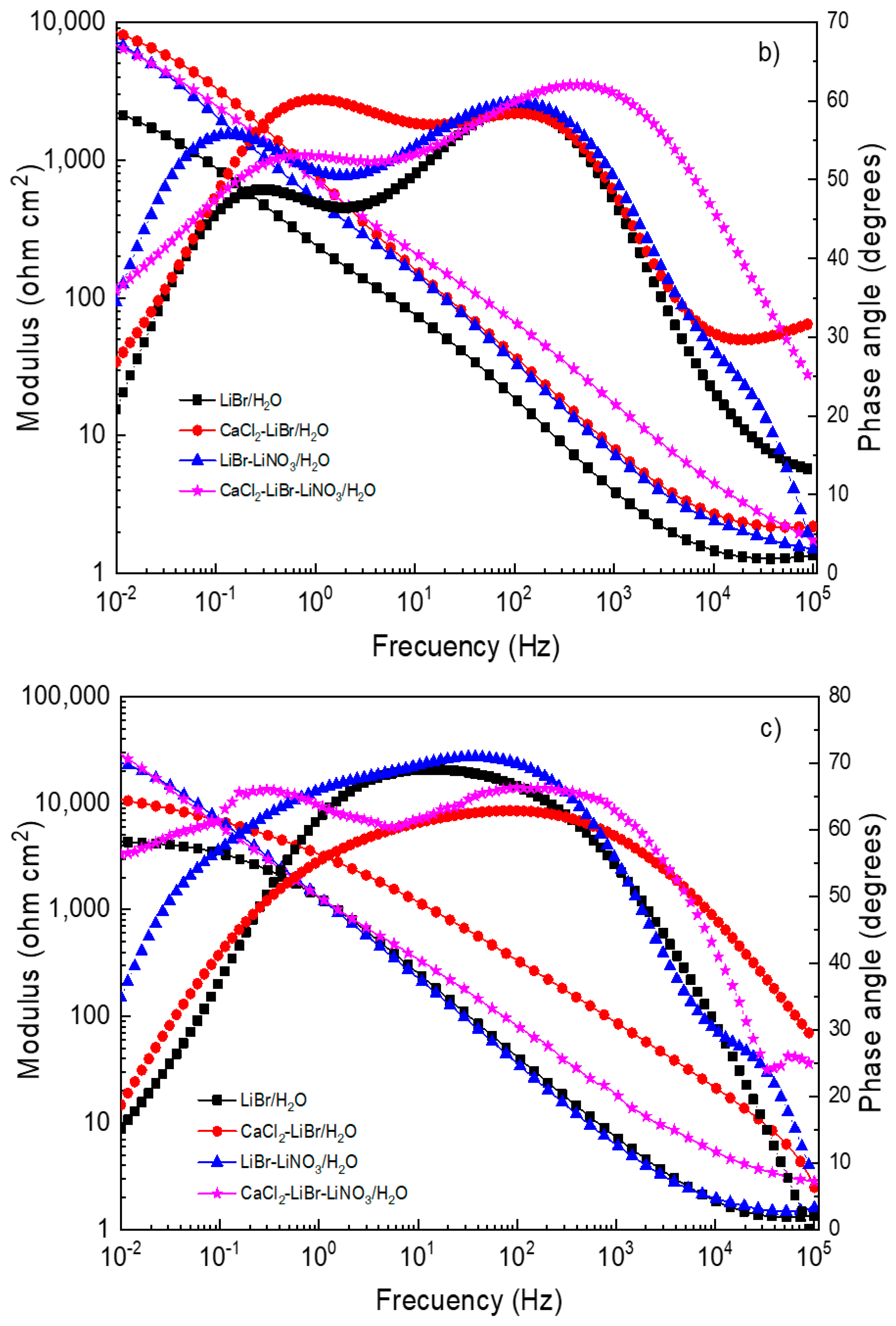
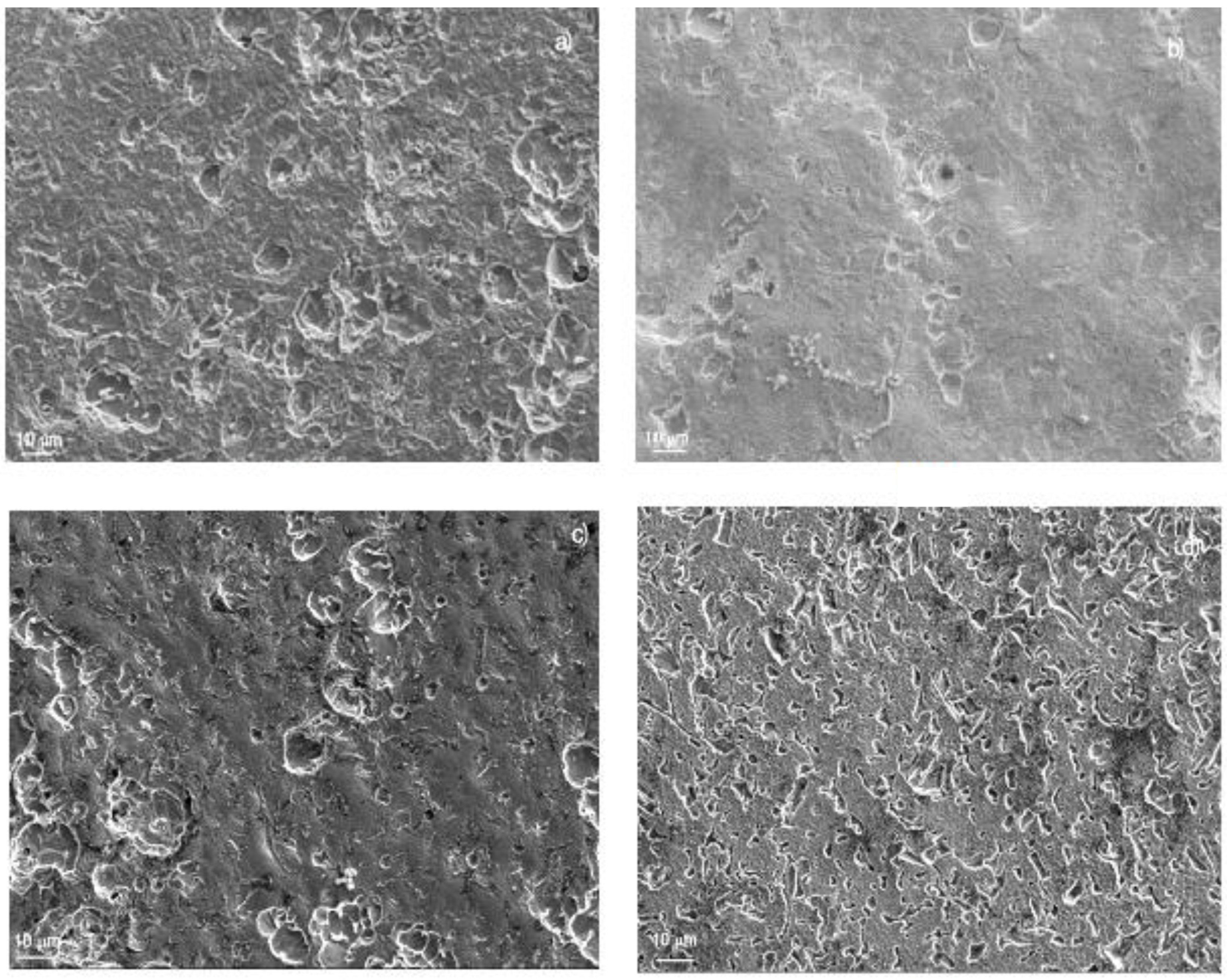
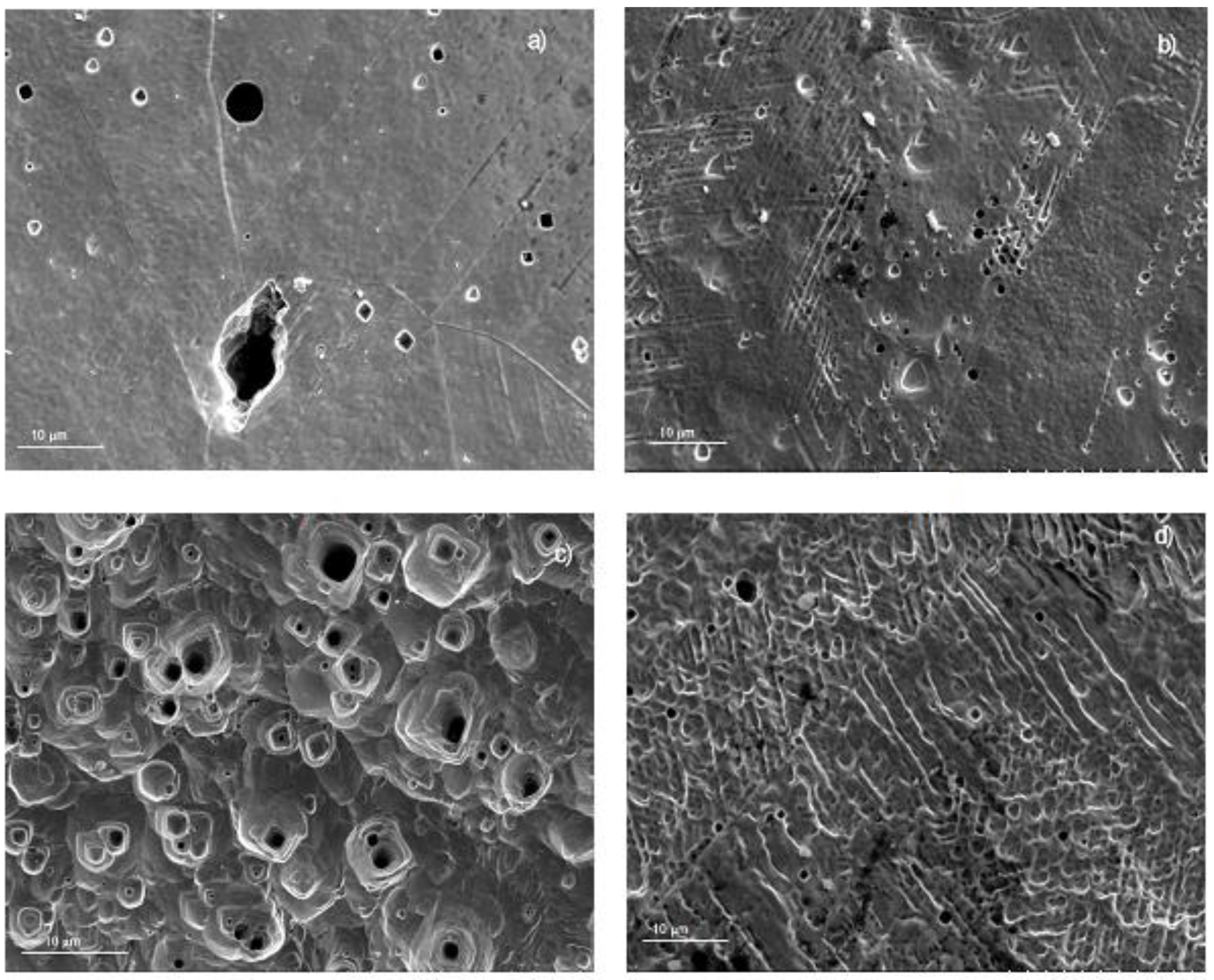
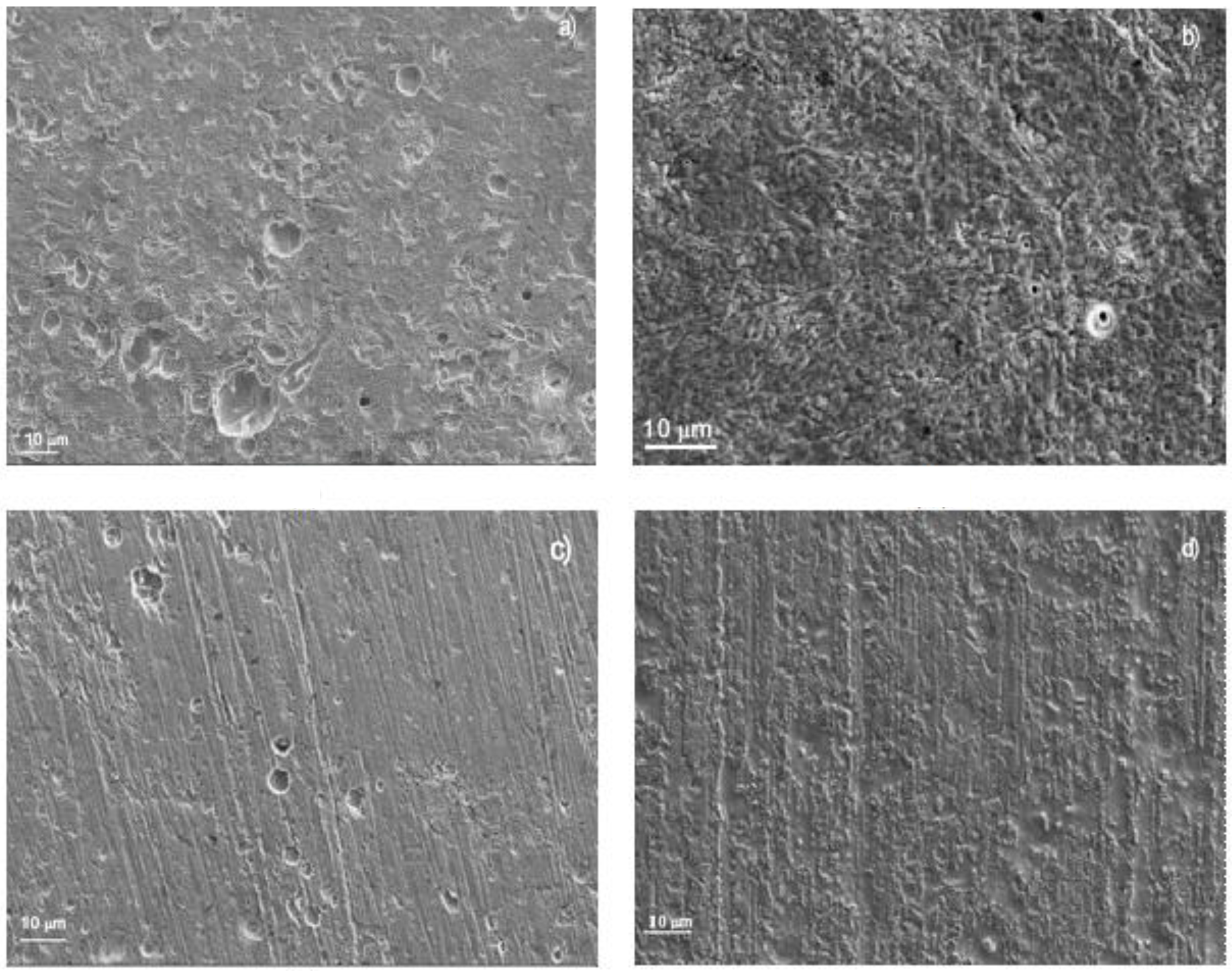

| Steel | Cr | Ni | Mo | Mn | C | P | S | Fe |
|---|---|---|---|---|---|---|---|---|
| 1018 | - | - | - | 0.90 | 0.14 | 0.03 | 0.03 | balance |
| 304 | 18.5 | 7.8 | 0.14 | 1.4 | 0.05 | 0.04 | 0.03 | balance |
| 316L | 16.7 | 10.8 | 2.3 | 1.6 | 0.02 | 0.04 | 0.03 | balance |
| Steel/ Environment | LiBr/H2O | LiBr/H2O+CaCl2 | LiBr/H2O+LiNO3 | LiBr/H2O+CaCl2 LiNO3 |
|---|---|---|---|---|
| 1018 | Uniform corrosion + shallow pits | Uniform corrosion + few pits | Uniform corrosion + few pits | High number of pits |
| 304 | Pits | Less, shallower pits | More, bigger pits | More, smaller pits |
| 316L | Pits | Much Less, smaller pits | Less, smaller pits | No pits |
| Solution | Steel | Rpit (ohm cm2) | CPEpit (ohm−1 sn) | nct | CPEf (ohm−1 sn) | Rf (ohm cm2) | nf | RL (ohm cm2) |
|---|---|---|---|---|---|---|---|---|
| LiBr+H2O | 1018 | 50 | 2.0 × 10−3 | 0.6 | - | - | - | 39 |
| 304 | 114 | 7.62 × 10−4 | 0.9 | 7.51 × 10−5 | 1.89 × 103 | 0.6 | - | |
| 316L | 277 | 2.20 × 10−4 | 0.9 | 3.55 × 10−5 | 4.36 × 104 | 0.6 | - | |
| LiBr+H2O +CaCl2 | 1018 | 205 | 1.6 × 10−3 | 0.4 | 1.02 × 10−3 | 190 | 0.8 | - |
| 304 | 263 | 7.46 × 10−4 | 0.8 | 1.86 × 10−5 | 7.12 × 103 | 0.5 | - | |
| 316L | 297 | 1.19 × 10−4 | 0.9 | 3.06 × 10−6 | 1.28 × 104 | 0.4 | - | |
| LiBr+H2O +LiNO3 | 1018 | 165 | 6.23 × 10−3 | 0.9 | 4.4 × 10−3 | 102 | 0.9 | - |
| 304 | 174 | 2.73 × 10−4 | 0.9 | 6.35 × 10−5 | 7563 × 103 | 0.4 | - | |
| 316L | 323 | 1.5 × 10−4 | 0.9 | 3.40 × 10−6 | 1.94 × 104 | 0.3 | - | |
| LiBr+H2O +CaCl2 +LiNO3 | 1018 | 140 | 6.28 × 10−3 | 0.6 | 1.3 × 10−3 | 75 | 0.7 | - |
| 304 | 193 | 6.90 × 10−4 | 0.9 | 3.35 × 10−4 | 5.78 × 103 | 0.5 | - | |
| 316L | 352 | 1.21 × 10−4 | 0.9 | 6.92 × 10−5 | 1.75 × 104 | 0.5 | - |
Publisher’s Note: MDPI stays neutral with regard to jurisdictional claims in published maps and institutional affiliations. |
© 2022 by the authors. Licensee MDPI, Basel, Switzerland. This article is an open access article distributed under the terms and conditions of the Creative Commons Attribution (CC BY) license (https://creativecommons.org/licenses/by/4.0/).
Share and Cite
Larios-Galvez, A.K.; Lopez-Sesenes, R.; Sarmiento-Bustos, E.; Rosales, I.; Uruchurtu-Chavarin, J.; Porcayo-Calderon, J.; Gonzalez-Rodriguez, J.G. Corrosion Behavior of Steels in LiBr–H2O–CaCl2–LiNO3 Systems. Metals 2022, 12, 279. https://doi.org/10.3390/met12020279
Larios-Galvez AK, Lopez-Sesenes R, Sarmiento-Bustos E, Rosales I, Uruchurtu-Chavarin J, Porcayo-Calderon J, Gonzalez-Rodriguez JG. Corrosion Behavior of Steels in LiBr–H2O–CaCl2–LiNO3 Systems. Metals. 2022; 12(2):279. https://doi.org/10.3390/met12020279
Chicago/Turabian StyleLarios-Galvez, Ana Karen, Roy Lopez-Sesenes, Estela Sarmiento-Bustos, Isai Rosales, Jorge Uruchurtu-Chavarin, Jesus Porcayo-Calderon, and Jose Gonzalo Gonzalez-Rodriguez. 2022. "Corrosion Behavior of Steels in LiBr–H2O–CaCl2–LiNO3 Systems" Metals 12, no. 2: 279. https://doi.org/10.3390/met12020279
APA StyleLarios-Galvez, A. K., Lopez-Sesenes, R., Sarmiento-Bustos, E., Rosales, I., Uruchurtu-Chavarin, J., Porcayo-Calderon, J., & Gonzalez-Rodriguez, J. G. (2022). Corrosion Behavior of Steels in LiBr–H2O–CaCl2–LiNO3 Systems. Metals, 12(2), 279. https://doi.org/10.3390/met12020279








